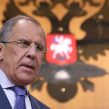
Moscow Juggling the Concept of Ukraine’s Territorial Integrity (Part Two)
Publication: Eurasia Daily Monitor Volume: 11 Issue: 224
By:

*To read Part One, please click here.
Moscow proposes to resolve the conflict in Donbas (eastern Ukrainian region encompassing the Donetsk and Luhansk provinces) by turning the Russian-controlled Donetsk and Luhansk territories into proto-states, to be linked with the rest of Ukraine in a quasi-confederal arrangement. Russia describes this as “restoring a single political space” of Ukraine, rather than a full and irreversible secession of those two areas from Ukraine (but still keeping a secession option in reserve). Concurrently, Russia is building up a regular military presence and agent network there, which would render any eventual political agreement dysfunctional, regardless of its legal form (see Part One in EDM, December 12).
Moscow acts in a triple role as conflict initiator, as diplomatic mediator between Kyiv and Russia’s own Donbas protégés, and as would-be overseer of the proposed settlement. In parallel with this solution for Donbas, Russia proposes to turn mainland Ukraine as a whole into a quasi-confederation of regions, an incoherent “space” rather than a state.
Moscow aims to achieve these objectives in two parallel negotiation processes: first, the ongoing negotiations over Donbas, and second, the upcoming internal debates in Ukraine about decentralization, which Russia wants to result in a “[con]federalized” Ukraine, a broken-up state.
Russia dominates the negotiations over Donbas in the Contact Group in Minsk by Western default. Emboldened, Moscow hopes to insert itself in the internal Ukrainian constitutional process with Western acquiescence, via some kind of international format, in which (if created) Moscow would play the first fiddle.
Downgrading Ukraine to a “space” is the latest in the series of Russia’s proposals to break up the country, one way or another. Moscow has demonstrated utmost tactical flexibility in formulating its territorial and political objectives in Ukraine, from the outset of this conflict to date.
During the early phase in March and April, Moscow called for “federalization” of mainland Ukraine, starting with the country’s “east and south.” Following the annexation of Crimea, the Kremlin launched the Novorossiya project, aiming to carve out eight of Ukraine’s eastern and southern provinces. The Donetsk and Luhansk “people’s republics” (“DPR-LPR”) held “referendums” on separation from Ukraine on May 11, as bridgeheads to a Novorossiya writ large. Those two “referendums” declared “samostoyatelnost,” i.e., less than outright independence (which would have been “nezavisimost”). President Vladimir Putin announced that Russia would “respect those referendums’ decisions,” building leverage through creative ambiguity (see EDM, May 9, 14).
Thus, Moscow reserved the full range of options for the future disposition of those territories: quasi-sovereignty in a “federalized” Ukraine, or merger into a wider Novorossiya (south-eastern Ukraine), or outright secession from Ukraine (with or without their “recognition” by Russia), or “unification” with Russia (whether in their own right or as part of a larger Novorossiya). The Novorossiya project has failed, at least for now; but Russia’s military intervention has cemented its control over parts of Donbas for the foreseeable future.
The armistice agreements, signed in Minsk on September 5 and September 19–20 under Russian duress, do not mention Ukraine’s territorial integrity or sovereignty. This omission reflects Russia’s changed attitude vis-à-vis those principles and the international order in Europe’s East. Russia had long paid lip service to territorial integrity and sovereignty, even when honoring them more in the breach than in the observance. But, even before attacking Ukraine this year, Russia had already moved to a highly conditional recognition of the territorial integrity of countries in Europe’s East. After seizing Crimea, the Kremlin has practically de-recognized the territorial integrity of mainland Ukraine. The September armistice agreements clearly withhold such recognition.
On November 2, the “DPR-LPR” staged “presidential and parliamentary elections” to create proto-states under Russia’s military protection. Russia, again, stopped short of endorsing their secession from Ukraine. In line with its flexible approach, Moscow announced that it would “respect the choice of the two republics’ voters.” With this, Moscow retains broad leeway for further bargaining, and a pressure tool against Ukraine. The November 2 “vote” supposedly produced “representative authorities” in the “DPR-LPR.” Ostensibly on this basis, Moscow is developing direct relations with those authorities, voiding Ukraine’s sovereignty there (see EDM, November 5, 12, 14).
Without officially recognizing the “DPR-LPR,” Russia treats them and the Ukrainian government practically on an equal footing in the Contact Group negotiations on implementing the armistice. Apart from that format, Moscow wants the Ukrainian government to enter into a direct political dialogue with the “DPR-LPR.” According to Russia’s Foreign Affairs Minister Sergei Lavrov, such a political dialogue could mark a “first move to launch constitutional reform in Ukraine with the participation of all the regions, political forces and ethnicities [Moscow’s diplomatic reference to Ukraine’s federalization]” (Interfax, December 10, 12).
Under such a scenario, an officially legitimized “DPR-LPR” enclave could spread centrifugal processes farther afield in Ukraine’s southeast. If this occurs in a context of deep economic and social crisis in Ukraine, the Kremlin could use that chance to reactivate its shelved Novorossyia project.




